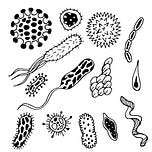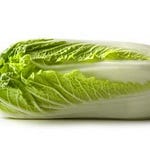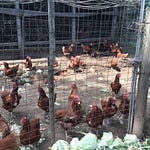Podcast Title: Microbes & Soil Tests
[Intro Music] (ARTIST) PALA: (SONG)ANDROMEDA
Welcome to the Probiotics Heal The World podcast! It is coming on the last week of July, and we’re to explore the relationships between Microbes, pH, and soil tests. I'm your host Eric Lancaster.
Anyone who enjoys gardening or farming or wants to better understand the ground they walk on will find soil testing a very useful tool. It's not simply soil; it's a dynamic ecosystem that supports life in ways we frequently take for granted.
Before grabbing a bag of fertilizer, it is best to collect water and soil samples and know the nutrient needs of the plants you will be planting. Never apply fertilizers without knowing what is left in the soil and what you need for the expected yields and plant type. You could cause all sorts of environmental problems doing this. When working with farms, I have always recommended soil samples before working the soil in early spring and post-harvest (or close to harvest). This gives the grower an idea of what they are starting with and what the plant has removed from the soil. It also lets you know if there are any toxic levels of nutrients in the soil. These tend to be micronutrient toxicities like Boron. You would be surprised how many farmers only test their soils every three years and fertilize every season.
The fundamental and complex relationship between soil microbes and nutrients is essential to maintaining life on Earth. Microbes in the soil, which include bacteria, fungi, archaea, and other small organisms, are essential to life. They serve as the natural world's recyclers and nutrient managers. They interact with the nutrients in the soil to form a dynamic ecosystem where the cycling and availability of vital components are carefully regulated.
We can learn more about a soil's fertility, nutritional composition, and potential difficulties by analyzing it. Thanks to this knowledge, we can make wise judgments concerning our plants and the land we value. Different types of tests can also tell if there is any contamination, the amount of microbial activity in the soil, and which microbes are actually in the soil. We will discuss some of these tests in the upcoming weeks.
Let's now discuss microorganisms or microbes, the tiny organisms like bacteria and fungi are the actual designers of life below the surface. They are essential to the nutrient cycling process because they make nutrients available to plants in absorbable forms. The breakdown of organic materials is one of microorganisms' main functions in the soil. Organic carbon is a valuable resource formed by accumulating dead plants, animals, and other organic materials on the top of the soil. Microbes break down these complicated chemical substances into less complex ones like carbon dioxide and different nutrients. Nitrogen, phosphorus, sulfur, and other vital elements trapped within the organic matter are released during this process, known as mineralization. Plants may now get these nutrients, which foster their development and sustain a vibrant plant community.
Some microorganisms have the unusual capacity to fix atmospheric nitrogen into a form that plants can use in addition to mineralization. For instance, nitrogen-fixing bacteria coexist harmoniously alongside leguminous plants (such as peas, beans, and clover). By working together, the bacteria transform atmospheric nitrogen gas into ammonia, which is then transformed into nitrogen compounds that the plant may use. This method is crucial to sustainable agriculture since it improves the soil with nitrogen and lessens the demand for fertilizers with nitrogen as a main ingredient.
Remember when we went over the Rhizophagy cycle? The rhizophagy cycle tracks the exact change point in root tips where many microbes are involved in making nutrients available to plants. In the plant’s root tip, they ingest microbes, dissolving their outer skin, which releases nutrients that the plant can absorb, providing the essential synergistic relationship between the plants and the soil microbes.
Additionally, mycorrhizal fungi and plants collaborate in another important way. These fungi penetrate the soil with their thread-like structures known as hyphae and build a mycorrhizal network that connects with plant roots. Mycorrhizal fungi increase the surface area of the root and improve nutrient uptake in exchange for the plant's sugars and carbohydrates. This is especially true for phosphorus and other mineral elements generally stationary in the soil. This mutualistic link between plants and mycorrhizal fungi considerably increases the ability of plants to receive nutrients and survive environmental stress.
The soil's microbes also contribute to the retention of nutrients. Some microbial communities "sequester" nutrients, making them available for plant absorption and reducing their loss to water evaporation. Holding onto nutrients preserves soil fertility and guards against losing vital components from agricultural areas.
It's important to remember that the balance between soil nutrients and bacteria is delicate. Environmental conditions such as soil pH, moisture, temperature, and nutrient levels influence microbial activity and diversity. Human activities, such as the excessive application of chemical fertilizers, can upset this equilibrium, which has a detrimental effect on the microbial populations in the soil and the cycling of nutrients. Adopting sustainable land management techniques is crucial because they result in better soils, greater crop yields, and environmental preservation. These techniques also promote a diversified and robust microbial community.
Ok. Let’s take a little break.
[Background Music]
Ad from Social Compost.
Background Music
And We’re back!
Now, let's discuss different approaches to taking soil samples. A soil test's accuracy relies on the samples collected. If you are new to this method, requesting nutrient recommendations with the analyses and talking with a local extension agent is a good idea. Watch some videos on how to take soil samples if you have never done it before. There are a few different methods. Pick the one that is right for your field. Find at least one good-quality lab and send out your samples. Some labs send you the containers they want the samples sent in and forms and directions. If you want to hone in on the numbers, send samples to three labs and take the average of all three results. Regardless, if you choose a lab, stick with that lab, as labs have different testing methods that can skew the results and throw off a program.
Here are a few essential tips to keep in mind:
Depth Matters: A 6 to 8-inch depth is ideal when collecting samples for most plants. This range captures the root zone, where most nutrient absorption occurs.
Random Sampling: Take samples from various spots within your garden or field. Avoid areas near obvious sources of nutrients like compost piles or fertilized patches. Test before your fertilizer, not after. This ensures a more comprehensive view of your soil's characteristics.
Composite Samples: If you have a large area to cover, consider creating a composite sample. Combine small amounts of soil taken from different spots, mix them thoroughly, and then submit the composite sample for testing.
Timing. Another crucial component of soil testing is timing. It is essential to collect samples at the right time, ideally before planting or during the off-season, for the results to be as accurate as possible. Doing this may resolve any nutrient imbalances before they affect your plants.
With this knowledge, we may adjust our farming and gardening practices to consider our soil's unique characteristics. Plant growth, yields, and the environment may all be improved by adjusting pH levels or adding the proper soil amendments.
[Outro Music]
I hope you’re enjoying these in-depth discussions about the relationship between soil testing and microbes. whether you are a farmer, gardener, running a greenhouse, or a homesteader, these topics affect anyone growing something that relies on soil. If you haven’t done soil samples yet, perhaps you could do your first set of samples this fall. If you’ve been fertilizing without samples, you may find that you didn’t need to. You may have just needed to add some microbes. We will discuss ways to test for that soon!
Join us next week on the Probiotics Heal The World Podcast!
{Music fades out] (ARTIST) ALSEVER LAKE:(SONG) NOBODY KNOWS
[End]









Share this post